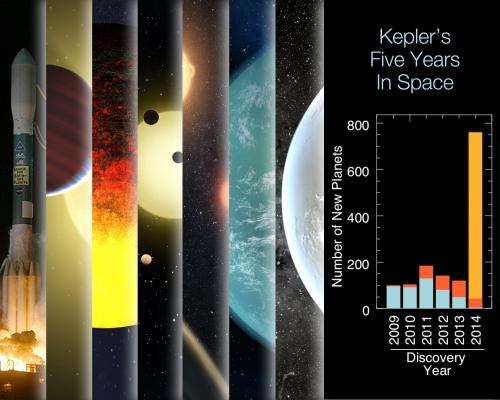Kepler marks five years in space

(Phys.org) —Five years ago today, on March 6, 2009, NASA's Kepler Space Telescope rocketed into the night skies above Cape Canaveral Air Force Station in Florida to find planets around other stars, called exoplanets, in search of potentially habitable worlds.
Since then, Kepler has unveiled a whole new side of our galaxy—one that is teeming with planets. Because of Kepler we now know that most stars have planets, Earth-sized planets are common, and planets quite unlike those in our solar system exist.
By analyzing Kepler data, scientists have identified more than 3,600 candidates believed to be planets, and verified that 961 of those candidates actually are planets, many as small as Earth. Discoveries made using Kepler now account for more than half of all the known exoplanets.
"During the last five years, Kepler has produced results needed to take the next big step forward in humankind's search for life in our galaxy— providing information needed for future missions that will ultimately determine the atmospheric composition of Earth-sized exoplanets to discover if they could be habitable," said William Borucki, Kepler principal investigator at NASA's Ames Research Center in Moffett Field, Calif.
Kepler's finds include planets that orbit in the habitable zone, the range of distances from a star where the surface temperature of an orbiting planet may be suitable for life-giving liquid water. One example of a habitable zone planet found by the mission is known as Kepler-22b. At 2.4 times the size of Earth, it is thought to be too big to be rocky and support life. Scientists believe other habitable zone planets found by the Kepler mission might be rocky, such as Kepler-62f, which is 40 percent larger in size than Earth.
A twin to Earth—a planet with the same temperature and size as Earth—has not yet been identified, but the analysis is far from over as scientists continue to search the Kepler data for the tiny signature of such a planet.
Other Kepler discoveries include hundreds of star systems hosting multiple planets, and have established a new class of planetary system where planets orbit more than one sun.
In August of last year, the mission ended its science observations after a faulty reaction wheel affected the telescope's ability to point precisely. The mission may be able to operate in a different mode, and continue to do science. This next-generation mission proposal, called K2, will be considered for funding by NASA in the 2014 Astrophysics Senior Review of Operating Missions.
Provided by NASA

















